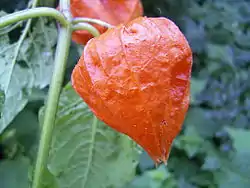鬼灯
Japanese

鬼灯 (hōzuki): the Chinese lantern plant, showing the fruit in its distinctive husk.
| Kanji in this term | |
|---|---|
| 鬼 | 灯 |
| Grade: S | Grade: 4 |
| irregular | |
| Alternative spelling |
|---|
| 鬼燈 (kyūjitai) |
Alternative forms
Etymology
Probably originally a compound of 頬 (hō, “cheeks”) + 付き (tsuki, “resembling, appearing like”, the 連用形 (ren'yōkei, “continuative or stem form”) of verb 付く tsuku “to stick → to become a certain state or quality”), from the way the husk vaguely resembles bulging red cheeks. The tsuki changes to zuki as an instance of rendaku (連濁).
The 鬼灯 kanji spelling is an example of jukujikun, literally meaning “demon's lantern”. The 酸漿 kanji spelling is from the Chinese term.
Noun
鬼灯 or 鬼灯 • (hōzuki) ←ほおづき (fooduki)?
- Alkekengi officinarum, syn. Physalis alkekengi
- Vernacular names include the Chinese lantern, Japanese lantern, bladder cherry, winter cherry, husk tomato, and the strawberry groundcherry.
Usage notes
As with many terms that name organisms, this term is often spelled in katakana, especially in biological contexts (where katakana is customary), as ホオズキ.
References
- Matsumura, Akira, editor (2006), 大辞林 [Daijirin] (in Japanese), Third edition, Tōkyō: Sanseidō, →ISBN
- Shōgaku Tosho (1988) 国語大辞典(新装版) [Unabridged Dictionary of Japanese (Revised Edition)] (in Japanese), Tōkyō: Shogakukan, →ISBN
This article is issued from Wiktionary. The text is licensed under Creative Commons - Attribution - Sharealike. Additional terms may apply for the media files.